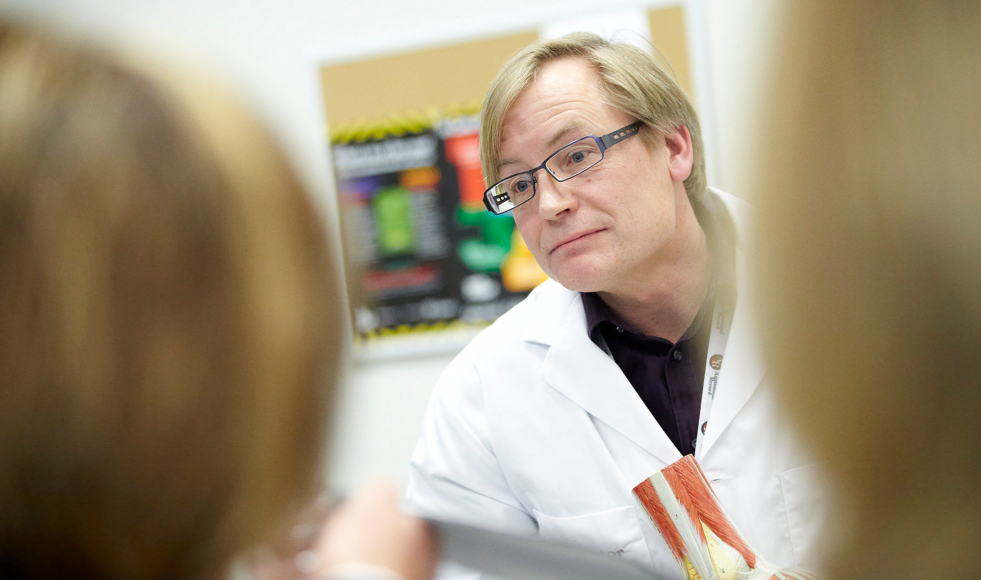Ethical questions raised about body donation after medically-assisted death

Bruce Wainman is director of the Education Program in Anatomy at McMaster University.
BY Tina Depko, Health Sciences
April 1, 2019
The legalization of medical assistance in dying (MAID) in Canada has resulted in some people choosing to donate their bodies to anatomy programs, but it has raised profound ethical issues, says McMaster’s head of anatomy.
Bruce Wainman, director of the Education Program in Anatomy, said the anatomical scientist community needs to establish guidelines around these donations.
The use of MAID, also known as “active voluntary euthanasia” or “voluntary euthanasia,” is legally obtainable in Belgium, Canada, Colombia, Germany, Luxembourg, the Netherlands, Switzerland, the United States and some parts of Australia.
As a result, Wainman said, there are issues about the appropriateness of accepting or using MAID body donations, communication with donors including consenting processes, and the transparency surrounding MAID donation with staff, faculty and students.
“These are profound questions that scrape at morals and ethics,” Wainman said. “I don’t think any of us have the answers right now.”
His article on the topic, co-authored with medical ethicist Jon Cornwall of the University of Otago in New Zealand, was published in the journal Anatomical Sciences Education.
“At this point, it is unclear how many anatomical programs have accepted or are accepting bodies of persons who end their life using MAID, as no reliable information exists on this topic,” said Wainman, professor of pathology and molecular medicine at McMaster.
“I wrote this discussion paper to raise the potential difficulties and ethical questions facing body donation programs where MAID exists, and to open the conversation. The last thing we would want to do is compromise our association with our community.”
The McMaster University body donation program has accepted six MAID bodies between the time the legislation was enacted in June 2016 and November 2018.
“Right after the law was passed in Canada, the bodies began to arrive,” Wainman said. “MAID makes up five per cent of our body donations now, but I can see it easily going to 10 per cent before the end of the year. That makes it five to 10 bodies a year.”
Wainman said the process of receiving and using bodies from donors who undertake MAID poses many challenges for institutions like McMaster.
“We have a tremendous relationship with many people in the palliative care field, so it comes up as a discussion point: ‘Are you interested in donating your body to anatomic study?’” he said. “We find the potential MAID donors are far more likely to want to donate their bodies to science. As a result, we are typically in contact with the donor themselves who reach out to us to talk about donation.
“An ethical question I face is that for these people who are so vulnerable, who are at that moment trying to decide if theirs is a life worth living, are we somehow inducing them to want to donate? Are we providing them with additional impetus to donate? It’s a serious issue as the last thing we want to do is to bring about any pressure at this difficult point in their lives.”
Then there’s the complexity about how to communicate the circumstances of these body donations with students in anatomy education programs at academic institutions, he noted.
Wainman said he decided upon the arrival of the first MAID body donation that his policy of transparency and openness at McMaster’s anatomy program would continue. He said everyone, from faculty members to students, who interact with the body donations know the circumstances. To date, no concerns have been expressed.
“We are having discussions – important discussions – in our anatomy lab on what it means to receive a body that has not died of natural causes,” he said. “On the death certificate it lists the cause which compelled them to seek MAID, not from medical assistance in death, but we are aware of the circumstances beyond that. It’s important in every possible way to be transparent. Everyone we train here at McMaster has an interest in human health, and this is an additional ethical issue for them to think about.
“Human health is not just about the function of your lungs and kidneys, it’s also about the person who lives in that body.”
There are guidelines around body donation to anatomy facilities, such as those from the International Federation of Associations of Anatomists (2012) and the American Association of Anatomists (2009).
However, Wainman pointed out these guidelines do not refer directly to the acceptance of MAID bodies, likely due to the newness of euthanasia laws. As such, the current guidelines are silent on the use of MAID bodies in the anatomical sciences.
“Further guidance from local and international recommendations are needed to raise awareness on this sensitive topic and ensure that MAID donors are treated with respect and that good practice around MAID donations can be consistently adopted,” said Wainman.
Wainman and Cornwall will be presenting on the issue at a summer meeting of the International Federation of Associations of Anatomists in London, England.
He said he expects there to be significant discussion as a result of the paper and subsequent presentations.
“This is such a new discussion for our field,” he said. “I’m sure we’re going to ignite a huge discussion, which is exactly the point of this article.”
Wainman added that the authors consulted with Sabine Hildebrandt, a medical ethicist and associate professor of pediatrics at Harvard University.
Read McMaster’s Brighter World profile piece on Wainman here.


